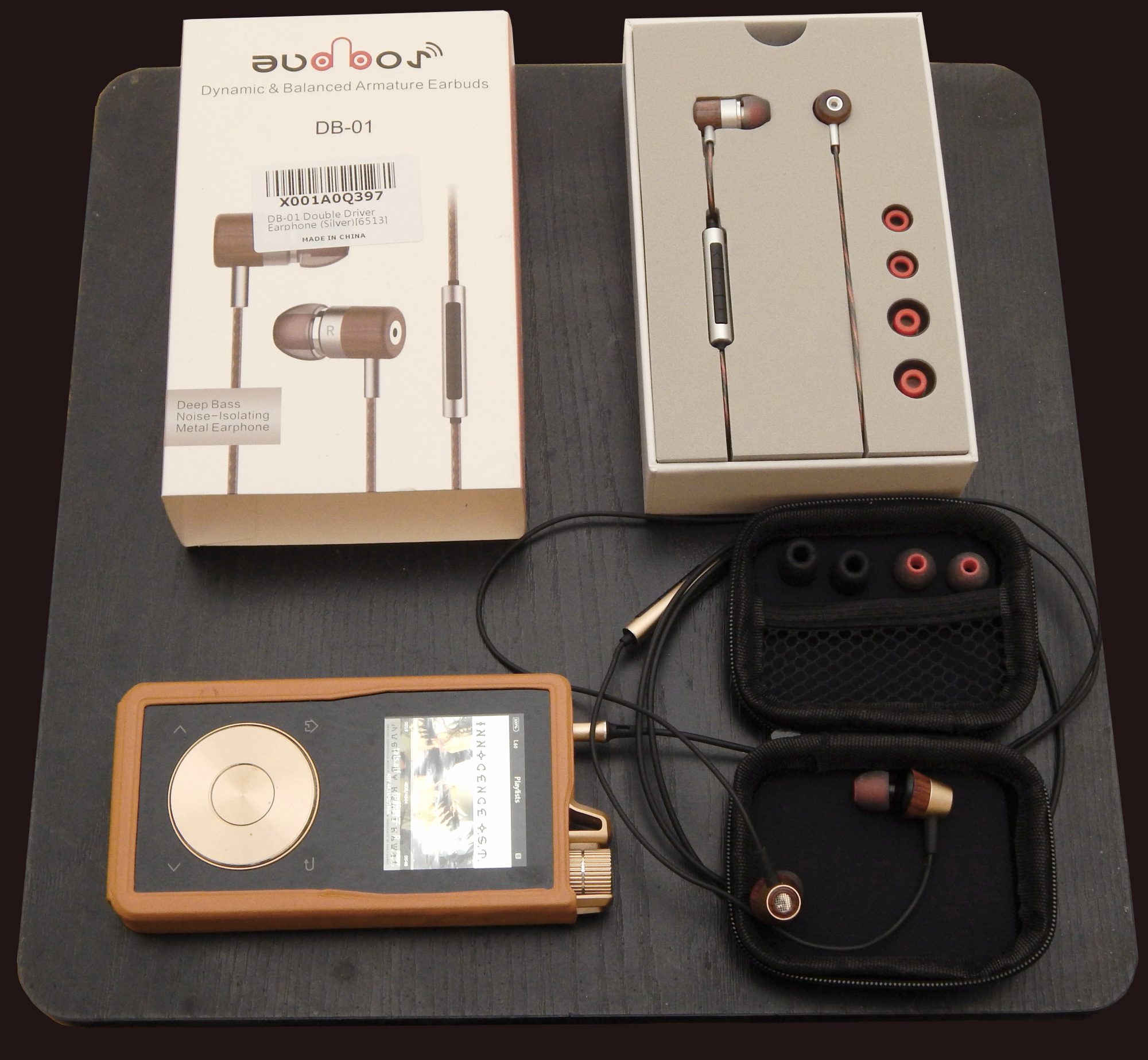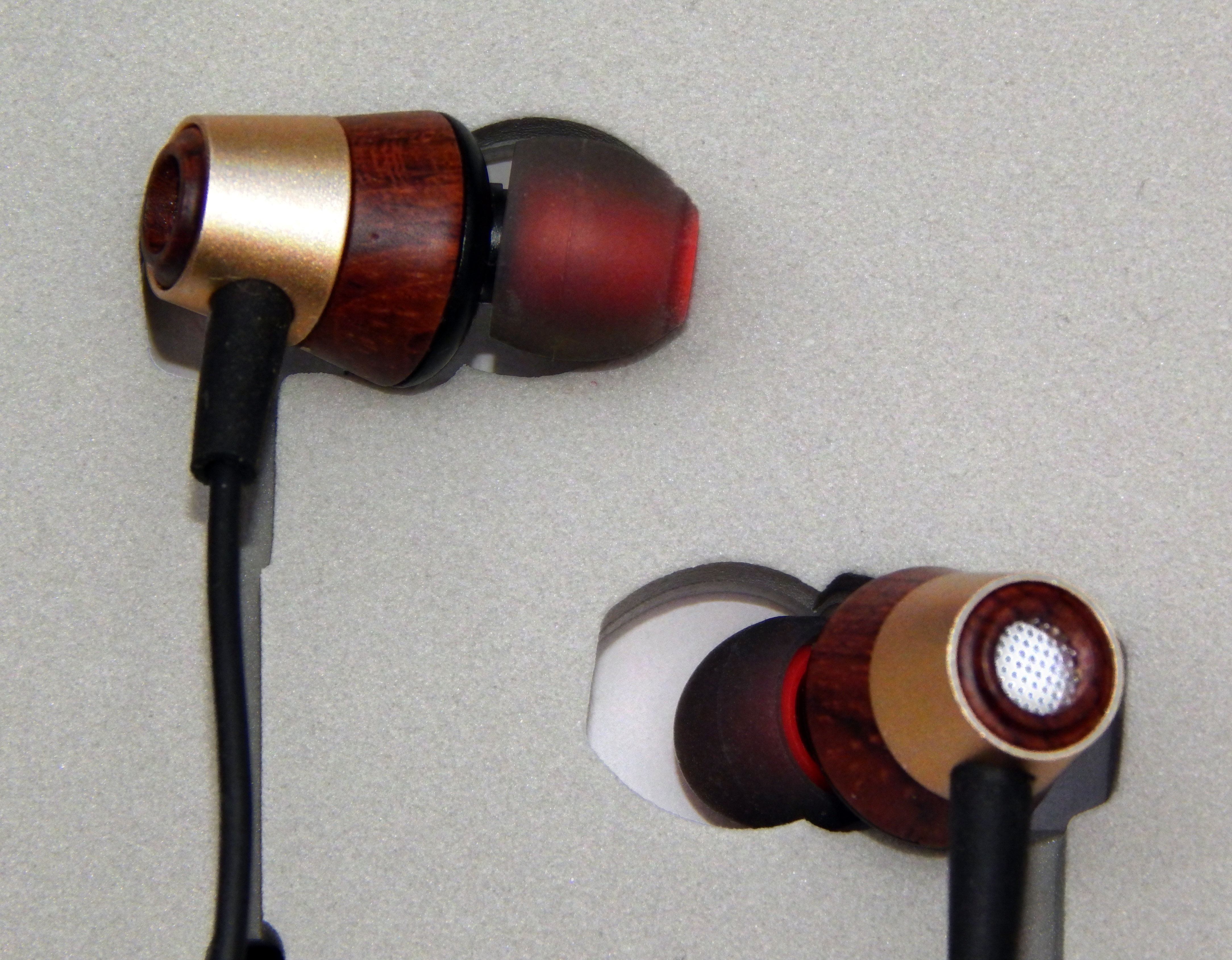AUDBOS is one of many new manufactures entering into the inexpensive high-performance In-Ear Monitor market, rushing to fulfill the demand created by the influx of cheap high quality DAPs and improved sound from smart phones. They offer two models of their Double Driver In-ear Deep Bass Noise Isolating Earphones; the DB-01 and the DB-02. Although essentially the same mechanically, they do differ in appearance, as well as sound due to how they fit in your ear, as much as, to a selection of three differently tuned tips.
The DB-01 have a simple tubular design wood and aluminum casing and come with three sizes of shallow large bore silicone tips along with a pair of deep large bore memory foam tips. The DB-02 on the other hand, employ a four piece cone shaped enclosure composed of a wood body fit to a black finished aluminum ear-piece with an angled bore, a gold toned aluminum ring at the back and a silver toned aluminum screen covering the rear port, and they come with a selection of three sizes deep small bore tips and what appears to be the same pair of deep large bore memory foam tips. By intermingling the two body styles and the three tip designs, you can achieve a fairly large array of sounds, which is especially helpful for those who prefer tailoring the sound of their IEMs to the music they listen to.
Both units are a hybrid design consisting of a dynamic driver and a balanced armature driver to maximize detail, dynamic range and low bass response, and both come equipped with a microphone and three button smart phone controller.
Unlike many IEMs I have tested, the AUDBOS are clearly marked right and left, although there does appear to be a convention of putting the microphone on the right (at least in my experience), still I appreciate the effort to make them more user friendly.
The packaging is well designed and elegant for such a moderately priced product and in addition to the selection of tips includes a small zip up carrying pouch.
The Sound Check:
After quite a bit of experimentation I settled on the DB-02s with the small deep small bore silicone tips (that’s small in size as well as bore). The DB-01s are louder and brighter, with slightly less bass than the DB-02s, and though this can be ameliorated by changing tips, the DB-02s still best fit my tastes and my ears (physically).
The sound isolation appears to be fairly good, making it easy to determine if you have a seal or not before playing. As they are extremely small and light, the comfort level is pretty high, though a cable clip would be appreciated as the cable is a bit microphonic.
To give all products the best possible advantage, I do my initial listening tests using my desktop reference rig; a Questyle Audio CAS192D DAC and CMA800R Headphone Amp. Starting as always with classical music, I listened to “The Firebird Suite” (Eiji Oue and the Minnesota Orchestra – Stravinsky – DSD). The soundstage was surprisingly large and the tympani had real impact. The tonal balance was lively and the dynamic range impressive, while the plucked cellos offered a great deal of resonance. The oboe and French horn as well as the strings were not exactly full bodied, but neither were they thin. The flute had an almost bell like quality to it.
For male vocals I turned to “The Gift” by Midge Ure. In addition to Midge’s unique guitar work and voice, he uses a lot of unusual percussion including snippets of sampled human voice, hammers on anvils and mechanical clocks as well as kettle drum. Again the presentation was huge. The frequency response natural and not the least bit fatiguing.
As counter point I chose Dusty Springfield and “The Look of Love” from Casino Royal (DSD). The piano had a balanced parlor atmosphere, to the right and back, the upright bass close at hand on the left, and Dusty in the center and intimate. The saxophone came a little from behind and alto, as was the concluding brass choral.
Shawn Colvin is not exactly rock and roll, but the bass on “Sunny Came Home” was deep precise and robust.
Switching to the Questyle Audio QP1 DAP the DB-02 came into its own, rendering “Killer Klowns from Outer Space” (The Dickies) with energy and excitement, easily able to achieve “live concert” levels from the “Low” gain setting, it was hard not to get lost in the music.
To test the limits of bass extension I selected “Can-Utility and the Coastliners” (Genesis – Foxtrot). Though a little bloomy around 100 Hz, the extension was good, yet the other instruments glided through clearly and articulate.
“Fantasia Suite” by Al DiMeola, Paco DeLucia & John McLaughlin (DSD) was presented very “Live” in an immense hall, with the competing guitars exhibiting a crisp bright tone.
Since the AUDBOS were clearly designed for use with smart phones, it was time to put them through their paces with Napster on my Samsung Galaxy Light. First up was Foreigner’s “Feels Like the First Time”. The bass was strong and the guitars, well, electric (despite the pun). The upper mids were a bit brittle and congested.
Though once again presenting a huge soundstage “The Wizard” by Uriah Heep also struggled with midrange detail clearly showing the defects of low resolution sources.
The simpler orchestrations of Steppenwolf’s “The Pusher” fared much better, the pulsing bass driving the song while the razor guitar filled in the atmosphere.
“Journey to the Center of the Mind” (The Amboy Dukes) was energetic and well articulated.
Seeking a little more modern recording technique I selected Regina Spektor (“Samson”). Her voice was a tad sibilant but not so much so as to make listening unpleasant. The piano was full if not warm.
Lissie’s “When I’m Alone” fed to the DB-02’s strengths being mostly bass and vocal, though the backing guitars were ringing.
The Sum Up:
AUDBOS DB-02 IEMs are not exactly what you would call forgiving, and the DB-01s less so providing a what you see is what you get sound, but they have definitely achieved the reverse bell curve tonal balance of strong bass and strong highs that they were going for in their hybrid dual driver design. Like most IEMs they are very efficient and an excellent match for any portable music player, and will perform as well as the source put to them.
On the other hand, while bright they are not harsh or abrasive, nor fatiguing during long listening sessions.
Most importantly, they are an amazing value, making it no hardship to buy both models to tweak the sound to your taste, which as mentioned at the beginning is ideal for those who like a different sound for different music.
Price: $59.99
Specifications:
Sensitivity: 101dB/mW
Impedance: 16 Ω
Frequency Response: 20-20kHz
Distortion: ≤1%
















Want to join discussion?
Feel free to contribute!